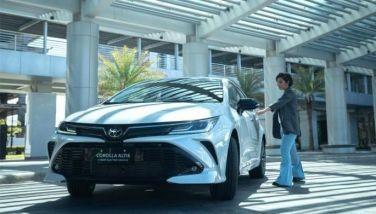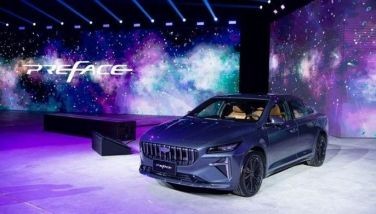Childhood Dream Come True
MANILA, Philippines - Want to drive a real-life Tonka truck? The Toyota FJ Cruiser is for you.
The moment the Toyota FJ Cruiser parked into my garage, I couldn’t help but grin like a high school kid. It’s like seeing my first Sports Illustrated swimsuit issue, only this time it’s with a two-ton (1,948kg to be exact) SUV. Naysayers will immediately point out that the FJ Cruiser isn’t practical: it’s huge, cramped, and thirsty; but this SUV manages to transcend these adjectives. Driving the FJ Cruiser is like dating a Victoria’s Secret Angel—you don’t go out with her because of her cooking skills; you date her because she’s hot. That’s the kind of magic spell the FJ Cruiser casts on you. It makes you live your childhood dreams of driving a real-life Tonka truck.
In terms of underpinnings, the FJ Cruiser has somewhat more modest beginnings: it’s based off the Land Cruiser Prado. But then, it went wild and actually transformed into something unique and beautiful. I don’t consider the Land Cruiser Prado to be pedestrian-looking, but next to the FJ Cruiser, it looks like a wallflower. It looks nothing like any other Toyota and that’s because the FJ Cruiser is a nod to the original FJ40 Land Cruiser—a model sold in the ’70s and ’80s. As such, it successfully captures nostalgia and bottles it in its round headlights, protruding front fenders, white roof, and chunky C-pillar. Beyond retro, the short overhangs, generous ground clearance, and chamfered edges all serve a purpose: it gives the FJ Cruiser excellent off-road prowess.
Taking a peek under its skirt, and you’ll find a clean view between the wheels—designed to achieve excellent suspension articulation and protection. Looking further up, there’s a solid rear axle with four links at the back and double wishbones in front—both having high suspension points. Even the spare tire has been mounted at the back to further improve the FJ Cruiser’s departure angle. Together with the Dunlop Grandtrek AT22 255/70R17 tires, the FJ Cruiser has almost 245mm of ground clearance with a 34-degree approach angle and 31-degree departure angle. Opening the large hood, you’ll find the same story with the FJ Cruiser’s engine bay. It shuns the current trend of mounting an engine as low as possible and puts it as high as it possibly can. It doesn’t do wonders to the FJ Cruiser’s center of gravity, but then again, this SUV wasn’t made to carve canyons; it was made to go over them.
The tractive effort for this canyon crawler is provided by a 4.0-liter V6 with 268hp and 380Nm of torque. Overall, it’s smooth and refined and can mimic the grunts made by a V8 engine, especially at lower revs. There’s a lot of power available early on, so it’s best to operate the accelerator with a light foot. However, if you find the urge to floor the gas, the FJ Cruiser can get going with gusto, chirping its tires in the process and quickly activating the 120 km/h alarm, which coincidentally, you can’t turn off. The sole transmission is a five-speed automatic which is just as smooth and refined as the engine. There are no steering wheel paddles or manual gear overrides, and you don’t need them; this transmission knows best. The FJ Cruiser comes with cruise control, but be warned: there are no indicators to tell you if it’s on or not. You’ll only know it’s on because you’re not slowing down. Surprisingly, despite its large engine and blocky aerodynamics, it manages 6.19 km/L city and 10.98 km/L highway. A disclaimer though: my city fuel figures were done during the post-Christmas season.
Staying on paved roads for the entire duration of this test drive, the FJ Cruiser is pleasantly comfortable. It’s no sports car or even crossover for that matter, so a readjustment is necessary when piloting it. For instance, visibility is compromised because of the upright windshield and ultra-thick A- and C-pillars. The FJ Cruiser also doesn’t have a high level of grip through corners and can feel severely “unbraked†on some occasions. That said, keep a calm demeanor during driving, and you’ll be rewarded with a ride that’s beautifully modulated. It glides through potholes like they weren’t there. The steering is surprisingly light, but there’s little feedback. But with a 2.7-turns lock-to-lock, the FJ Cruiser has a surprisingly tight 6.2-meter turning radius.
Admittedly, I’m not a hardcore off-roader, so I’ll have to trust other people when they say the FJ Cruiser has excellent off-road credentials. Unlike some SUVs, the FJ Cruiser isn’t a full-time four-wheel drive machine. It runs purely on two-wheels until you shift (on-the-fly) to four-wheel drive. The Philippine-spec unit comes with a Lockable Rear Differential among the usual Vehicle Stability Control and Traction Control.
Mirroring the FJ Cruiser’s playful exterior, the interior is filled with both nostalgic and purposeful touches you won’t find anywhere else. For instance, it features a plastic washable floor with the floor mats serving as the only cloth covering for your feet. Then you have the color-coordinated center console and door panels which match the exterior paint creating a young atmosphere. The chunky controls from the air conditioning knobs to the gearlever and the transfer case are nice touches and so is the dash-mounted triple-meter cluster. The cup holders and center console bin are lined in rubber too, reducing unwanted rattles brought about by loose change and canned drinks.
As good as the interior is the experience also isn’t perfect. For one, ingress and egress is quite a feat in the FJ Cruiser given there are no side step boards to speak of. And then you have the hidden clamshell rear doors. This means if you’re picking someone up who needs to get in back, you or your front passenger will need to unbuckle your seatbelt, open the front door before the rear door can be opened. And lastly, the rear seats are tight, smaller than a compact sedan even; a surprise given the FJ Cruiser’s generous exterior size. However, if you do plan to treat the FJ Cruiser solely as a toy of sorts, the rear seats do fold down in a 60/40 split, maxing out at 1,891 liters (790 liters with the rear seats up). And the rear glass can open separately from the rest of the hatch, a joy in tight parking spots.
Priced at just P1,798,000, the FJ Cruiser surprised many with its affordable pricing, especially considering the 4WD Fortuner is just P33,000 cheaper. So where did Toyota shave off some savings to price this Japan-CBU SUV so aggressively? Interior features. Yes, if there’s a single complaint I’ll lodge with the FJ is its lack of creature features. To name a few, the FJ lacks: fog lamps, courtesy wipe (for the wiper), adjustable dimmer for the instrument cluster, multi-function trip computer, USB input for the audio, and side and curtain airbags. Thankfully, it has an auto-dimming rearview mirror and parking sensors as standard equipment (trust me, you’ll need it).
In the end, the Toyota FJ Cruiser isn’t for every SUV buyer. If you want something much more practical that seats seven, there’s always the Fortuner; something more carlike and agile? The RAV 4. Clearly, FJ Cruiser isn’t exactly the best choice when it comes to an everyday driver. Again, it’s like dating a supermodel. She may not be the most practical girl on the planet, but given the choice, wouldn’t you date one?
- Latest



























